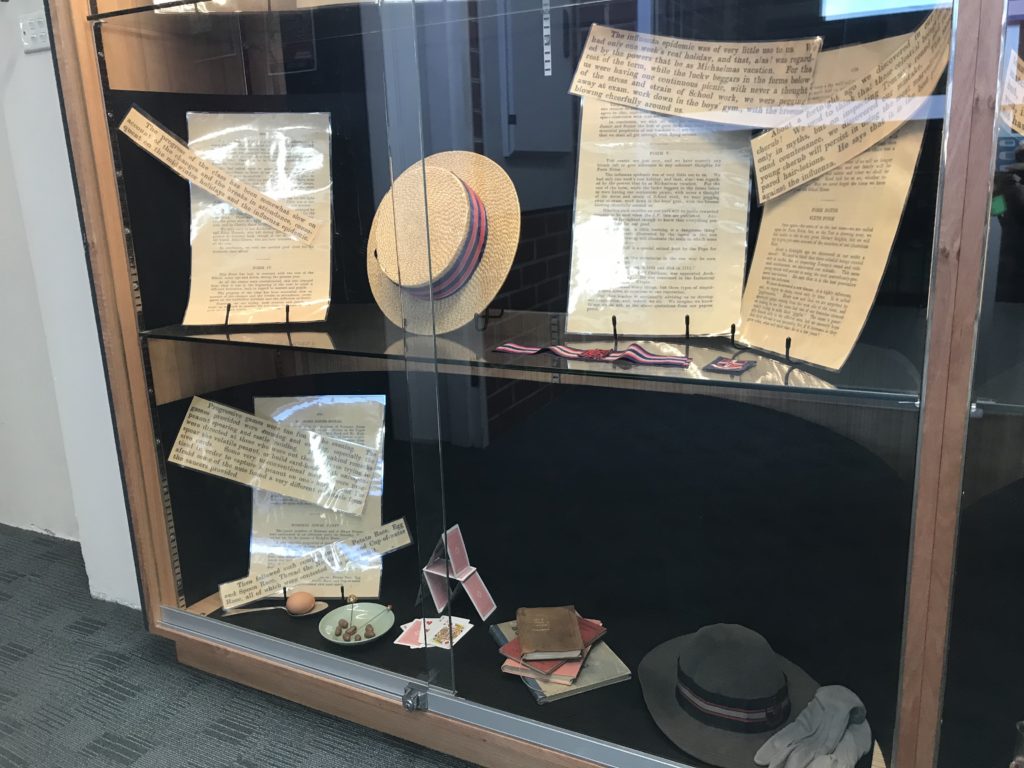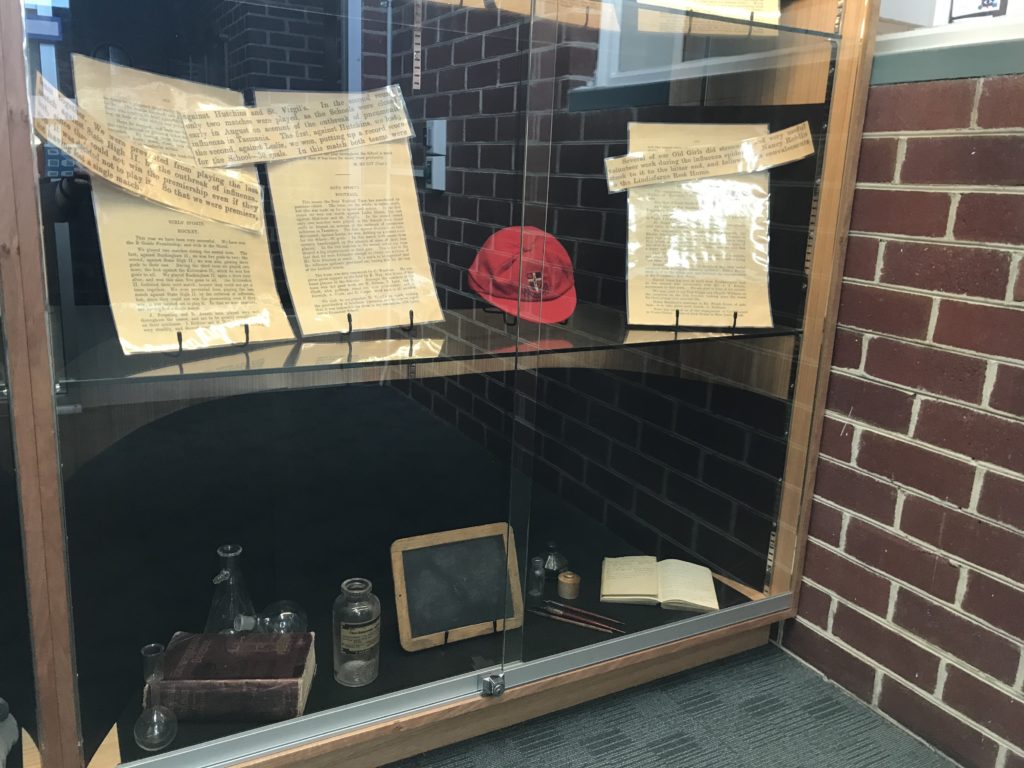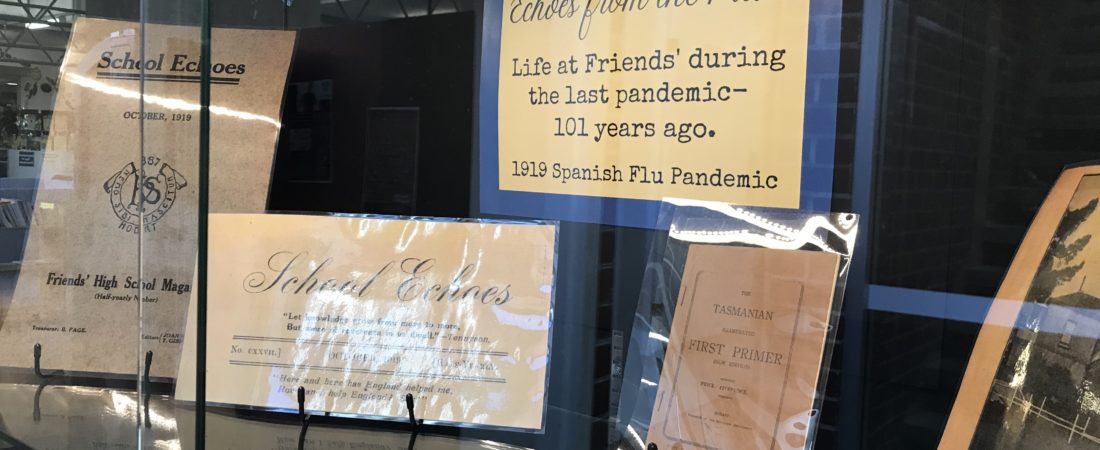The Last Pandemic
Posted on November 16, 2020
Thank you to Nicole Parums (High School Library Technician) for this fascinating article about the last pandemic.

As 2020 draws to a close and we reflect on a year of challenge and change, it is interesting to look back even further to 1919 to a snapshot of school life and to see how the Friends’ community responded to the last great pandemic – the influenza pandemic of 1918-1919, also known as the Spanish Flu. The October 1919 issue of Echoes gives us many insights, starting with the following editorial note:
“We intended to publish “School Echoes” before the Michaelmas [September] holidays, but, owing to the influenza epidemic, we were prevented from doing so, but we hope that it is not too late for this effort to meet with appreciation”. (p.1194)
Towards the end of World War One, serious cases of influenza were being reported – first amongst soldiers. The virus spread rapidly into the civilian population and by the end of 1918 the influenza pandemic had spread around the world following trade routes and shipping lines.
Tasmania enforced some of the strictest quarantine measures in the world. Returning soldiers were quarantined on Bruny Island. The pandemic hit the mainland first and border closures early in the year affected the school:
“…the influenza epidemic on the mainland prevented our overseas Boarders from returning to School until after Easter – in fact, some are not back yet…” (p.1194)
In August 1919 when the flu arrived in Tasmania, the school was forced to close, disrupting many activities including House competitions:
“In the third term, the second round of matches had just been arranged when the epidemic broke out in Hobart and the school was closed for seven weeks, as were all the other schools in Tasmania.” (p.1194)
Exam preparations for older students continued, however:
“While the school was closed because of the influenza epidemic permission was obtained from the health authorities to carry on with the preparation of senior students for University examinations on condition that they sat two feet apart and that there were no more than six to a room.” The Rose and the Waratah, p.224.
Some girl boarders attending the school remained during the closure:
“During the influenza epidemic School was closed, but eight of us remained here. The first week we experienced solitary confinement, then, for several other weeks, we were not allowed to go for any picnics. Still we had our fun. We held several tennis tournaments amongst ourselves.” (p.1195)
Despite the pandemic and the stresses of exams, the spirits of the older students remained high. Sixth Form reported an outbreak of “giggleomania” and quite an advance in medical science:
“This same young cherub will persist in using the most marvellously-prepared hair-lotions. He says that it is the best preventative against the influenza.” (p.1199)
Due to a shortage of firewood students had to go without fires in class rooms. But there were no book shortages in the library:
“Our library was well stocked with good books last term, and we were able to do a great deal of interesting reading.” (p.1203)

Fourth Form felt the impact of the pandemic:
“This form had, in common with the rest of the School, many ups and downs during the present year… The progress of the class has been somewhat slow on account of… the breaks in attendance, consequent on the midwinter holidays and the influenza epidemic. However, we are trying, both masters and pupils, to make up as much as possible for lost time, and hope to do a good bit of work before the end of the year”. (p.1202)
How fortunate we are in 2020 to have access to the technology that enabled our distance learning program.
It seems that maybe the younger students were sheltered from the pandemic. Things of note in Third Form included squeaky desks, the gift of a pot plant which they forgot to water and a few good hockey players. Second Form “earn[ed] money at home for the war victims in France” and noted “the spring flowers… peeping up in our gardens after their long winter sleep. Alan, Graeme, and Wilfred are growing vegetables.” The thirty five students in Kindergarten were learning about children from other countries and how to use chopsticks. Some Kindergarteners were planting lobelia seedlings and looking forward to growing vegetables.
The school’s Literary Society continued with strength throughout the year. In June, students:
“…had the pleasure of hearing a lantern lecture on the “Solar System,” by Dr. Thomas. The slides (some of which Dr. Thomas had made himself) showing the physical features of the moon and the sun, and the structure and movements of the planets, created intense interest.” (p.1206)
Attendance was good, averaging 68 per meeting over the five meetings held, however:
“The meeting arranged for September had to be abandoned, owing to the influenza vacation. This was a disappointment, as the Mock Trial, arranged by the Sixth Form for that date, promised to be a very interesting programme.” (p.1206)
To encourage contributions to “Echoes” the committee offered a prize for the best series of three Limericks addressing the theme “Scenes in the Playground”:
“The response was disappointing, only six entries being received – none of very great merit.” (p.1210)
Gladly we have moved on from such ‘encouragement’ in the school today! Here is one of the winning limericks by George Walker – you can judge its merits for yourself:
“Have you heard of our captain, named Dimse?
Of his head we catch never a glimpse –
When up for a mark,
He flies like a lark ;
There’s been snow on his head ever since.” (p. 1210)
The girls’ hockey and boys’ football seasons were disrupted by the pandemic, with matches cancelled. The boys improved in the first part of the season:
“…due to the fact that we were fortunate enough to obtain the services of Mr. Eric Absolom as coach. It is much regretted that the influenza epidemic prevented our having him for the rest of the football season.” (p.1214)
Eric Absolom was a local player of some note and also umpired football matches in Hobart. It seems he was a bit of a ‘character’. He became the proprietor of the Criterion Hotel and was fined in 1924 for after-hours trading. He was shot at close range over an argument about a straw hat and later became a race horse owner and trainer.
School activities including the Ransome house social and Hodgkin house party went ahead which included activities such as peanut spearing, building card-houses and an egg and spoon race. The house system was introduced in 1918 by Headmaster Charles Annells who believed:
“… it would stimulate the interests of more students in sport and work and hence develop and quicken the school spirit. The school was divided into three houses. Boarders were grouped in School House (colour blue) and day students in Ransome (red) and Hodgkin (gold).” The Rose and the Waratah, p.223.
Excursions were put on hold for a time including those of the Natural History Society:
“We hoped to have many more excursions, but the outbreak of influenza prevented us from carrying out our plans. We went [on] one excursion on the Saturday before the schools were closed… We went up past the Cascades in the hope of finding some orchids, but it was a little too early for them, and we were obliged to content ourselves with ferns and mosses.” (p. 1216)
With many people needing medical care, volunteer help was needed and The Friends’ School old scholars did their bit:
“Several of our Old Girls did strenuous and very useful volunteer work during the influenza epidemic. Nancy Roblin stuck it to the bitter end, and followed the convalescents to the Lindisfarne Rest Home.”
Nancy had trained in first aid in 1918 and later went on to qualify as a nurse, passing her Australasian Trained Nurses’ Association examinations in May 1923.
Our teachers in 2020 continue to work hard and innovate. Advances in technology enabled our distance learning program and maintained a sense of connection. We can continue to navigate our way through this pandemic with the confidence that we are better equipped technologically and medically and with a greater understanding of the emotional and psychological needs of the members of our school community. Many things have changed in the 101 years between pandemics, but what has remained at The Friends’ School is a strong sense of community and optimism, and a commitment to the wellbeing and education of our students.
Nicole Parums | Library Technician
Sources:
Hurst, J (ed.) 1919, School echoes : October, 1919, The Friends’ School, Hobart.
Kobasa, P (ed.) 2009, Pandemics, World Book, Inc., Chicago.
National Library of Australia n.d., Search. Uncover. Australia, Canberra, viewed 2 November 2020, <https://trove.nla.gov.au>.
Oats, W 1979, The rose and the waratah : The Friends’ School Hobart formation and development 1832-1945, The Friends’ School, Hobart.
